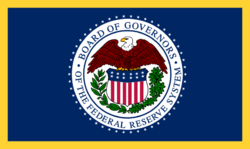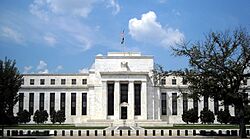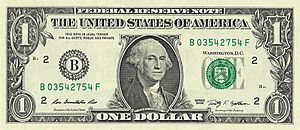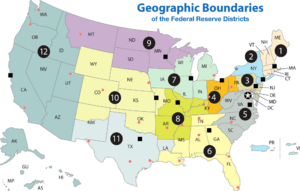Federal Reserve facts for kids

Seal of the Federal Reserve System
|
|

Flag of the Federal Reserve System
|
|

The Eccles Building in Washington, D.C., which serves as the Federal Reserve System's headquarters
|
|
| Headquarters | Eccles Building, Washington, D.C., U.S. |
|---|---|
| Established | December 23, 1913 |
| Governing body | Board of Governors |
| Key people |
|
| Central bank of | United States |
| Currency | United States dollar USD (ISO 4217) |
| Reserve requirements | None |
| Bank rate | 4.50% |
| Interest rate target | 4.25–4.50% |
| Interest on reserves | 4.40% |
| Interest paid on excess reserves? | Yes |
| Federal Reserve | |
| Agency overview | |
| Jurisdiction | Federal government of the United States |
| Child agency |
|
| Key document |
|

The Federal Reserve, often called "The Fed," is like the heart of the United States' money system. It works to keep the country's economy healthy and stable.
The Federal Reserve is a complex organization, but it plays a vital role in the United States economy. By understanding what the Fed does, you can better understand how the economy works and how it affects your life.
Contents
What is the Federal Reserve?
The Federal Reserve System is the central bank of the United States. Imagine a regular bank where people keep their money, borrow money, and make payments. The Federal Reserve is a bank for banks! It helps make sure all the banks in the country are doing well and that the economy is running smoothly.
Why was the Federal Reserve created?
Before the Federal Reserve, the United States had some big problems with its money and banks. Sometimes, people would panic and rush to take their money out of the banks all at once, causing the banks to run out of money and even close down. This was called a "banking panic."
In 1907, there was a really bad banking panic that made people realize how important it was to have a central bank. So, Congress decided to create the Federal Reserve to help prevent these problems in the future.
What does the Fed do?
The Federal Reserve has several important jobs:
1. Keeping Prices Stable
The Fed tries to make sure that prices for things like food, clothes, and toys don't go up too quickly (inflation) or go down too much (deflation).
2. Maximum Employment
The Fed wants as many people as possible to have jobs. When people have jobs, they can earn money and buy things, which helps the economy grow. The Fed works to create conditions that help businesses grow and hire more people.
3. Supervising Banks
The Fed keeps an eye on banks to make sure they are following the rules and not taking too many risks. This helps to protect people's money and keep the banking system safe.
4. Managing the Money Supply
The Fed controls how much money is available in the economy. It can increase or decrease the amount of money to help keep the economy stable.
5. Being a Bank for Banks
The Fed provides financial services to banks, like lending them money when they need it. It also helps banks move money around the country.
How does the Fed do all this?
The Federal Reserve uses several tools to do its job:
Interest Rates
The Fed can change the interest rate (the cost of borrowing money) that banks charge each other for borrowing money. When the Fed lowers interest rates, it becomes cheaper to borrow money, which encourages people and businesses to spend more. When the Fed raises interest rates, it becomes more expensive to borrow money, which encourages people and businesses to save more and spend less.
Reserve Requirements
The Fed can change the amount of money that banks are required to keep in reserve. If the Fed lowers the reserve requirement, banks have more money to lend out, which can help the economy grow. If the Fed raises the reserve requirement, banks have less money to lend out, which can slow down the economy.
Open Market Operations
The Fed can buy or sell government bonds (certificates representing money the government has borrowed) to increase or decrease the amount of money in the economy. When the Fed buys bonds, it puts more money into the economy. When the Fed sells bonds, it takes money out of the economy.
Who runs the Fed?
The Federal Reserve is run by a group of people called the Board of Governors. There are seven members on the Board, and they are appointed by the President of the United States and confirmed by the Senate.
The current chairman of the Federal Reserve is Jerome Powell, as of April 1, 2025. He helps to make important decisions about the economy and how to keep it healthy.
Federal Reserve System
The Federal Reserve System isn't just one big bank in Washington, D.C. It's made up of 12 regional Federal Reserve Banks located around the country.
These regional banks work together with the Board of Governors to make sure the whole country's economy is doing well. Each of the 12 Federal Reserve Banks offers economic education programs for teachers. Some banks offer programs for students, and many have exhibits or museums that school groups can visit.
The Fed and the Economy
The Federal Reserve plays a very important role in the economy. It helps to keep prices stable, create jobs, and keep the banking system safe. By using its tools wisely, the Fed can help the economy grow and make sure that everyone has a chance to succeed.
Fun facts about the Federal Reserve
- The Federal Reserve was created in 1913, more than 100 years ago!
- The Fed has a special building in Washington, D.C., called the Marriner S. Eccles Federal Reserve Board Building.
- The Fed is responsible for making sure there are enough dollar bills and coins in circulation.
- The Fed works with other central banks around the world to keep the global economy stable.
Images for kids
-
Ben Bernanke (lower-right), Former Chairman of the Federal Reserve Board of Governors, at a House Financial Services Committee hearing on February 10, 2009. Members of the Board frequently testify before congressional committees such as this one. The Senate equivalent of the House Financial Services Committee is the Senate Committee on Banking, Housing, and Urban Affairs.
See also
 In Spanish: Sistema de la Reserva Federal para niños
In Spanish: Sistema de la Reserva Federal para niños






